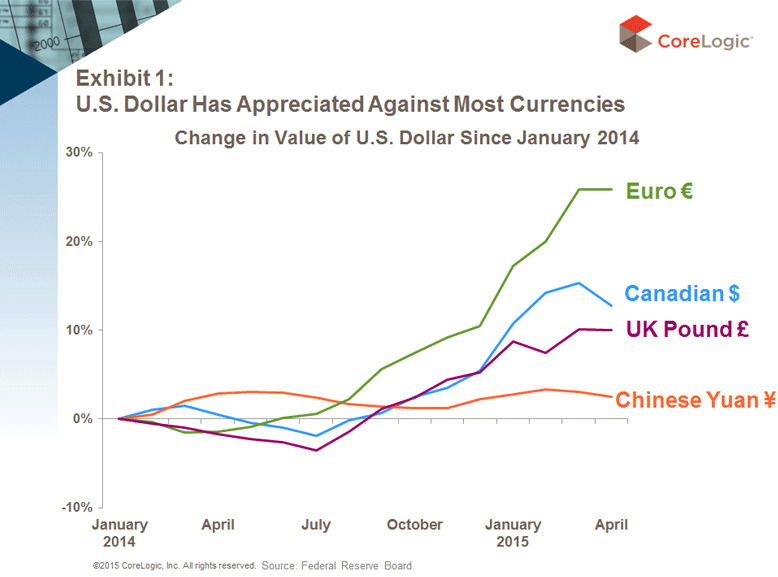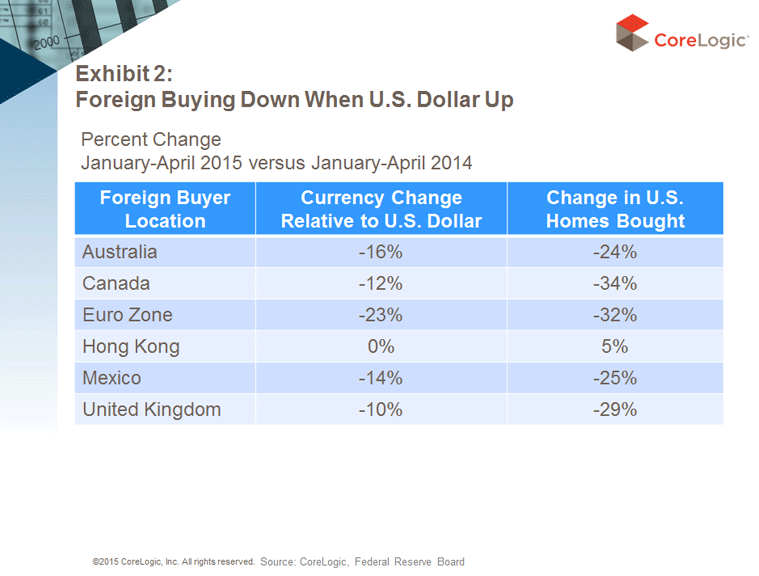Blog

Strong Dollar Deterring Foreign Home Buyers
While home sales are sailing, recently closing in on numbers last seenrnbefore the Great Recession, CoreLogic Senior Economist Frank Nothaft, pointsrnout that one group of buyers is sitting on the sidelines. Foreign buyers havernsubstantially diminished in market share.</p
While home sales during the first four months of 2015 were 9 percent higherrnthan a year earlier, the National Association of Realtors® (NAR) says the portionrnof those buyers self-identified as foreign dropped 19 percent. These buyers are not a huge sector – therndecline took the market share from 2.5 percent to 2.0 percent, but they are importantrnin some cities. </p
The decline has occurred even as interest rates dropped, down about a halfrnpercent from the same period in 2014, and NAR says its agents report it is apparentlyrnthe result of the strong American dollar. rnAbout three-quarters of agents who work with international clientsrnreport that foreign exchange rates have had a significant impact on housingrnpurchases.</p
Of course when the dollar strengthens relative to other currencies thatrnmoney, Japanese yen. Chinese yuan, the euro, buy less in this country while therndollar buys more in those countries. As exhibit 1 shows, from the beginning ofrn2014 through April 2015 the dollar gained 10 percent relative to the UnitedrnKingdom pound and 13 percent on the Canadian dollar. The euro has been particularly affected,rnlosing 26 percent in buying strength, most of it since the beginning of thisrnyear when the financial situation in Greece became more critical. The yuan andrnthe Hong Kong dollar have better held their value over that period. </p
 </p
</p
As Exhibit 2 shows, those countries where currencies have depreciated thernmost have been those whose citizens have most pulled back from buyingrnproperties in the U.S.; down between one-quarter to one third during the periodrnin selected locations. Buyers from the aforementioned Hong Kong have increasedrntheir market share. </p
 </p
</p
Nothaft says the sticker shock caused by the stronger dollars is furtherrnaggravated by strong price appreciation in those U.S. markets that tend tornattract foreign buyers such as the Southeast coast. Many Canadians, Europeans and South Americansrngravitate to that area for the beaches, cultural amenities, warm winterrntemperatures and accessibility. Canadians made roughly two-thirds of their U.S.rnhome purchases during the first four months of both 2014 and 2015 in Florida,rnnearly half of them in the Miami-Fort Lauderdale-Palm Beach area. Prices there rose about 7 to 8 percent fromrnApril 2014 to April 2015. Coupled with the effect of a stronger dollar the averagernCanadian considering a home purchase in south Florida saw a jump in purchaserncost of 20 to 25 percent in the past year.</p
Of course currencies fluctuate on a nearly daily basis and Nothaft pointsrnout that foreign buying could continue to decline, level off or increase inrn2016 depending on the relative value of the dollar against the various currencies. He adds, “The uncertainties surrounding howrnthe Eurozone will resolve the debt crisis in Greece has made it more difficultrnto project foreign currency movements.”
All Content Copyright © 2003 – 2009 Brown House Media, Inc. All Rights Reserved.nReproduction in any form without permission of MortgageNewsDaily.com is prohibited.
Latest Articles
By John Gittelsohn August 24, 2020, 4:00 AM PDT Some of the largest real estate investors are walking away from Read More...
Late-Stage Delinquencies are SurgingAug 21 2020, 11:59AM Like the report from Black Knight earlier today, the second quarter National Delinquency Survey from the Read More...
Published by the Federal Reserve Bank of San FranciscoIt was recently published by the Federal Reserve Bank of San Francisco, which is about as official as you can Read More...

Comments
Leave a Comment